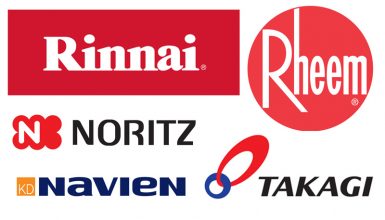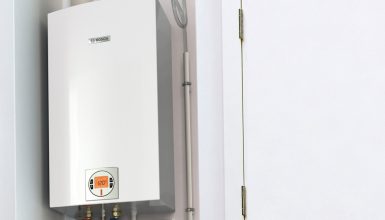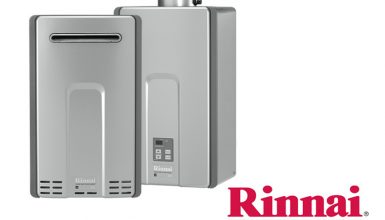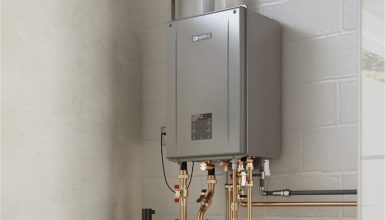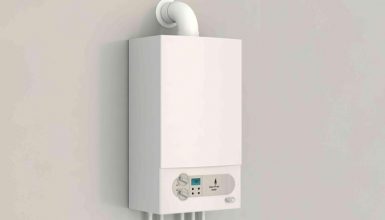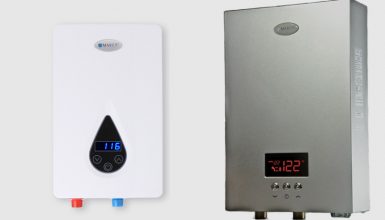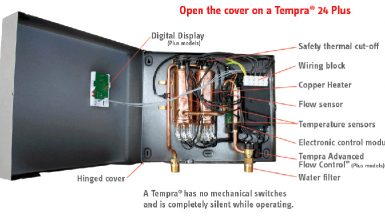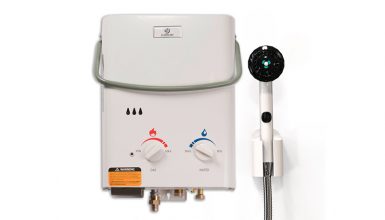If you’re tired of running out of hot water while you’re taking a shower and paying sky high energy bills, then an electric tankless water heater may be the solution you’ve been looking for.
In this review of Ecosmart vs. Titan vs. Stieben Eltron vs. Rheem vs. iHeat, we’ll explain each product. Giving you the features, pros, and cons, so you can decide which electric tankless water heater is best for you.
Ecosmart vs. Titan vs. Stieben Eltron vs. Rheem vs. iHeat Comparison




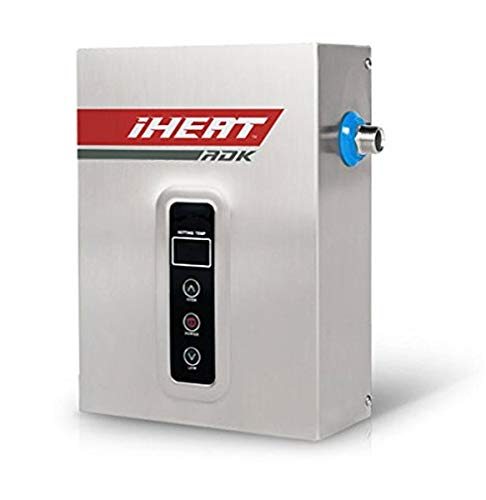





1. Ecosmart ECO 36

Starting off our list of electric tankless water heaters is the Ecosmart ECO 36. This unit is the best of the best as far as whole house electric tankless water heaters go. When we say the top of the line, that’s no exaggeration as we’ll explain in detail.
First off, this unit carries the title of being a whole house tankless water heater very seriously. It can handle multiple bathrooms and appliances running at the same time with ease. This is in due, in part, to its outstanding GPM which stands for gallons-per-minute. If you live in a larger home or are part of a bigger family, then this unit will service your needs exceptionally well.
Secondly, let’s look at the installation required for this water heater. As this is an electric water heater, electrical wiring will be part of the installation. This unit can put out some serious power if it is installed correctly all the way up to 36 kW.
However, if you can’t support this much power with your current electrical system, you can consider upgrading though that can become expensive. We highly recommend having a professional come out to install this unit and deal with the electrical wiring for your safety.
Another thing to mention is that your local climate can affect the performance of your water heater. If you live in cold climate areas, that means the incoming water will be significantly colder. This, in turn, takes the water heater longer to heat up than normal.
If you’re on the flip side of that equation and live in much warmer climates, then you won’t have a problem having hot water because the incoming water won’t be too cold. So, where you live at is important to consider before purchasing.
Pros
- Save space up to 90%
- Powerful and proficient
- Lifetime warranty for residential
- Allows you to adjust the temperature to the exact degree
- Energy saving as it only uses as much power as needed
Cons
- Installation may require electrical upgrades which could be costly
- Living in cold climates can affect how much hot water you have
In short, the Ecosmart ECO 36 is an exceptional electric tankless heater that gets the job done. Highlighted by its power and high efficiency, this unit is more than able to cover hot water needs for larger homes and families with ease. The installation does have the possibility to become expensive especially if you want to get the most out of this unit.
Outside of that, however, there are not many negatives one can say about this unit. Be sure to check where you live and how that weather can affect this heater before you run to the store to buy it. We believe this tankless water heater is well worth the buy and worth your consideration!
2. Stiebel Eltron Tempra Plus 24

The next unit on this list is no slacker when it comes to producing hot water for you. Some would even consider the Stiebel Eltron Tempra 24 the best electric tankless water heater in today’s market. So, why is this unit garnering such high praises? Let’s take a look.
To begin with, the Tempra 24 has a sleek design and is compact, so you don’t have to worry about losing any room to a water heater. Along with this, it also boasts a dial selector which allows you to choose the exact water temperature that you want. This can range anywhere from 86 to 140 degrees F.
Speaking of hot water, this unit can consistently deliver it to you. This unit excels in providing hot water very quickly without the hassle. Tempra’s advanced technology allows this unit to work in determining the water flow and temperature followed by it adjusting to ensure hot water arrives at you. The best part is that this unit can even function at high levels when the demand is high as well. Whether you have just one shower running or two plus a washing machine, this unit can still deliver.
One other thing to consider, once more, is the climate of your local area. Unlike some electric heaters, however, the Tempra 24 can perform in both warm and cold climates. With that said, it will perform better in warmer climates because of the higher temperature of the incoming water. In colder climates, it will take a bit longer to heat the water up, but not a significant amount of time. This makes it a very versatile unit to own whether you live far north, far south, or if you’re in the Midwest.
Pros
- Small and compact size
- Energy efficiency
- No venting required
- Can support multiple bathrooms
- Performs well in cold and warm climates
Cons
- Installation requires a professional meaning extra cost
- Pressure can be an issue if too many showers/appliances are running
The Tempra 24 is a champion in the world of electric tankless water heaters and for a good reason. Its ability to handle warm and cold climates along with its efficiency in energy make it an excellent choice for anyone looking to buy an electric tankless heater. Be sure to take into consideration the cost of having a professional come and install it before purchasing.
3. Rheem RTEX-13

Coming up next on our list is the Rheem tankless water heater RTE 13. This is one of the smaller units out there and is designed accordingly for small apartments and homes. Weighing just eight pounds, it is certainly not a large unit meaning it won’t take up much room. The water heater itself consists of a gray, metal box with a panel on the front that allows you to adjust the temperature. In short, it sports a simple look with few bells and whistles.
The first thing to know about this water heater system is that it can’t handle big projects. Unlike other water heater systems, this unit is best designed for small apartments or a small home with 1-2 residents. However, it cannot handle larger homes with multiple bathrooms or appliances. This will end up with you only having lukewarm water and being sorely disappointed. It can run well with a few sinks and a bathtub, but that’s where this unit reaches its limits. That’s not to say this is a bad water heater. It’s just not suited for large demands of hot water.
This unit is also not suited for cold climates. Our previous water heaters have been able to withstand the cold with a slight wait time on the hot water. With this unit, it simply cannot deal with cold incoming water and so should not be placed in that cold weather climate. It will work best when in a warm weather climate where the incoming water is 60-65 degrees F.
The RTE also requires you have at least a 60-amp breaker before installing this unit. If you have anything less, you risk it overloading your breaker and dimming your lights or losing power momentarily. It regularly puts out 54 amps of electricity, which is a lot of power for such a small unit. To put it simply, this unit is not very energy-efficient and so does not save you much money on energy.
Pros
- Works well with small apartments in warm climates
- Continuous hot water on demand
- Modulating heat exchanger improves energy efficiency
- Small, so it saves space
Cons
- Not very powerful
- Unable to perform in cold climates
- Unable to support multiple bathrooms or appliances
In short, the Rheem RTE 13 is a good unit if you’re only looking to service a sink or two or perhaps just one shower. However, if you are looking to run anything else beyond that, then this unit will not be a good fit for you.
4. Titan SCR2 N-120

Up next on our list is the Titan SCR2 N-120. This unit stands tall among other tankless electric water heaters out there. It brings much to the table for your consideration as a viable water heater, so let’s dive in and look at what it has to offer.
First up, we’ll look at the Titan’s continuous heating capability. Essentially, this means that there is hot water for you whenever you need hot water. This cuts down on waiting around for the water to heat up when it comes to filling a bathtub or washing dishes. We all can relate to having to wait for the water to heat up, but this unit fixes that problem by giving you hot water on demand.
Like many other water heaters out there, the climate will affect this unit’s performance. It performs best in a warmer climate where the incoming water is around 65F. However, this unit can still perform in colder climates without much difficulty. The only downside to having this unit in colder climates is the wait time that comes with it. The unit will need more time to heat the water up in the cold rather than in a warmer climate area.
This unit also can support anywhere from small apartments to medium-sized homes. However, this unit is not designed to support huge homes with 3-4 bathrooms along with appliances running as well. This can put a strain on the unit and cause the water to warm instead of hot.
One issue that this unit has, however, is many people report having to reset the unit often. Difficulties would arise from the unit dealing with erratic temperatures in the water requiring a reset of the system. While this is certainly not the case with every single unit, it is something to take into consideration when purchasing a water heater.
Pros
- Its ability to provide continuous heating
- Energy efficiency
- Can operate in both warm and cold climates
Cons
- Can require a reset of the system at times
- Not well-suited for much larger homes
To close, this unit can get the job done, and there’s not much to complain about with it either. It’s energy-efficient, and its continuous heating is a huge plus for homeowners. We recommend you look at this unit if you live in a smaller home and want a well-rounded out the water heater.
5. iHeat Tankless S-16

The last of our electric tankless water heaters, but certainly not the least of them is the iHeat S-16. This unit can do just as much work as the other systems. Unlike some of the smaller units on this list, the iHeat S-16 is still capable of performing at a high level in small apartments to even larger homes depending on what you need and how much hot water you use. Let’s dive in to see what all it includes.
Firstly, this unit can run at 3.5 GPM. This means that it can run with two showers and an appliance at the same time or two appliances and one shower depending on whatever you’re doing. The point is that this unit has lots of power and can run exceptionally well. This makes it best suited for your larger homes and those whose families use up a lot of hot water.
The iHeat S-16 is also designed specifically for warmer climate areas. This means that those of you who live in colder climates may need to look at another unit because this one will not work well for you. If you live in southern states, this unit will get the job done for you routinely and without any issues.
This unit also contains with stainless steel components that help to prevent corrosion of the unit. This helps maintain the unit giving it an extra boost in durability. Durability is key in water heaters as you need them to last a long time without having to spend more money on repairs or replacements. So, having a durable unit is very appealing.
Pros
- Energy-efficient
- Small and compact size
- Can be installed outside of the home
- Powerful and able to support larger homes
Cons
- Cannot perform in cold climates
- Installation may require a professional
In short, this unit works well for those of you who live in warmer climates and have a huge demand for hot water. It can handle that massive demand with its 3.5 GPM with ease and is designed specifically for the warm weather. We highly recommend this unit if it applies to where you live and what you need. It will certainly get the job done for you.
Sizing Guide
Finding that perfect electric tankless water heater that best suits your needs can be difficult to do. It’s even more challenging when there are so many different types of tankless water heater that you can look at.
The first thing to do is determine how much hot water you use in a typical day. If you have a larger family, you probably have 3-4 showers a day with one or two loads of laundry to do as well.
However, you may live alone and just have one shower each day plus laundry once or twice a week. There’s a significant difference there in hot water usage. This means there will be a huge difference in water heaters that you look at.

The capabilities of a water heater are broken down into FHR and GPM. FHR stands for first-hour-rating, and GPM stands for gallons-per-minute. This means that the water heater has a set rating for how much water it can produce in the first hour before it must start reheating the water while GPM is how much water it can produce per minute.
The next thing to look at when purchasing a water heater is your local climate. Most of the water heaters out there excel in warmer climates, but some units can perform just as well in the cold.
If you purchase a water heater designed for warmer climates, but you live in cold weather, then your unit will fail at its job. Climate is a fundamental component in selecting a water heater, and you should be informed about this before buying one.
Since we dealt with electric tankless water heaters, it is only fair we discuss the electrical side of this in our sizing guide. First off, it’s important to know the capabilities of your current electrical system. You don’t want to buy a system that requires 60-amp voltage when your house can’t support that much.
Find out what your limitations are and then begin searching for a water heater that fits within that boundary comfortably. This way, you won’t blow your breaker and lose your power.
Installation
Conclusion
If you’re looking for a more consistent, instantaneous supply of hot water and want to reduce your energy use, we highly recommend Ecosmart ECO and Stiebel Eltron Tempra electric tankless water heater.
References:
Energy Cost Calculator for Electric and Gas Water Heaters
Electric Vs. Gas Water Heater Comparison Test

